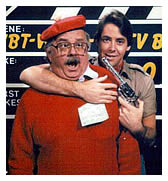
Jim Patterson in the clutches of Alan Ryan in a WBTV Blood Give-In promo.


Jim Patterson in the clutches of Alan Ryan in a WBTV Blood Give-In promo.
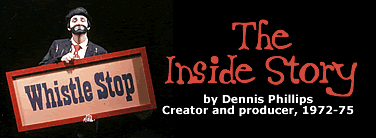
WBTV, like all local stations in the Golden Years of TV, produced more than its share of children's shows. As television matured in the 1960s several programming issues affected children's programming. One was the end of the official baby boom in 1964. There were fewer children watching. In the mid 1960s the FCC mandated that all TV sets had to receive UHF TV signals and that led to many UHF stations finally becoming economically viable. As they came on the air they programmed old sitcoms and classic TV and some stations carried syndicated children's shows and program strips as their niche in the increasingly crowded dial.
TV advertising-sales demographics shifted to older teens and sponsorships for a local children's show was a tougher sell for the local TV sales department. Add to that the increasing cost of producing local TV programming and local children's shows began their long decline.
The final "shot heard 'round the channels" was the creation of Sesame Street for PBS in 1969. The urban-hip show with the Muppets and a carefully crafted educational slant along with clever merchandising and funding became the juggernaut and force to be reckoned with by local commercial children's shows. Many local stations just gave up on daily morning or afternoon children's shows.
The last blow for daily local children's TV was the FCC decision in 1971 to ban local children's show hosts from doing commercials within their shows.
There was, however, still a great deal of pressure from the FCC for local stations to do "local programming." That included children's programming.
In 1971 the FCC attacked network TV. They made all the networks divest themselves of their production companies. Another rule was that the FCC forbid the networks from providing programming in the 7 to 8 PM hour. The reason was the FCC wanted local stations to do locally originated programming.
The plan backfired, for most local stations just stripped in game shows.
The FCC also tightened up the licensing procedures for granting TV licenses. One bonus point for getting your license renewed by the FCC was to have a locally produced educational children's TV show! In the Spring of 1972 these factors were on the mind of Fred Barber and his successor John Edgerton as well as Pat Lee, the head of WBTV creative services. At that point, the only locally-produced children's show on the WBTV schedule was “Fred Kirby's Little Rascals” co-starring Uncle Jim.
Fred Kirby was a legend and his Sunday afternoon show was a Carolina tradition.
Greg Rose had been hired as a WBTV local salesman in early 1972. Greg came from WDBJ-TV, a CBS affiliate in Roanoke, Virginia. Here is where fate collides with opportunity. I had been working with Greg at WDBJ-TV. I was writing, directing, producing, playing a character on their local kid's show and even working on their affiliated FM radio station with Adrian Cronauer (later his Vietnam story was used for the movie"Good Morning, Vietnam"). I had just graduated from college in the Washington, D.C. area with a degree in Elementary Education. During college I worked almost full time in radio and TV in the Washington and Baltimore markets. My boyhood friend in Norfolk, Virginia was Bob McAllister who went on to host the syndicated children's show "Wonderama" on WNEW-TV in New York. I was a magician, ventriloquist, sketch artist, puppeteer, musician and character actor.
In March of 1972, I proposed marriage to a Roanoke kindergarten teacher and she accepted! (Cindy and I have been married for 34 years). I decided I needed more money from television and that meant a bigger market. Greg Rose arranged a meeting for me with Pat Lee at WBTV. I was hired as a producer-writer and director to fill the slot of Reno Bailey who was moving to Jefferson Productions on the other side of the building. In back of Pat's thinking was my ability to create some sort of educational children's show. I had a demo reel of bits I had done on Roanoke TV and I recall Pat Lee and John Hutchinson enjoying my use of Chroma Key, odd-looking puppets and visual comedy.
I moved to Charlotte and WBTV in April of 1972 and much of my energy was focused on creating the brand new weekly children's show for a September programming launch. Cindy finished her teaching obligations in Roanoke in June and we were married and she joined me in Charlotte. Cindy would play a part in creating the puppets and costumes for the show as well as a sounding board for many of my ideas.
|
||||||||||||||||
The cast: Jim Patterson, Fred Kirby, |
My major challenge was to create a program and use the strengths of Fred Kirby and Jim Patterson and yet focus them in an educational direction.
For it all to work, Fred would have to accept my concepts and writing and not feel threatened. We became instant friends. Jim Patterson became like a father to me. I settled on a "train station" theme because Fred was closely associated as a spokesman for Tweetsie Railroad. He loved the idea! It seemed the kind of imaginary location where lots of interesting situations could develop. "Uncle Jim Mahaffey" Patterson became the station master. Working in the WBTV Community Service department was Clara Lowry. She was photogenic, a great singer and a natural on camera. Clara and her musician husband, Mason, had a jazz and blues singing act.
During the Summer of 1972, Rick Frye, Steve Johnson and I did the concepts and drawings for the set. Ed Wade, George Booker and I built it in the Jefferson Productions workshop. We did not have the set completed by the premiere date, the second Saturday in September 1972, so the first show was "The Move to Whistle Stop." We rolled the cameras out the studio door and into the road and used a baggage cart with the wooden barrel and suitcases and gave a preview of what the show would be like when we got to Whistle Stop. By the second week we were in the studio.
When the November 1972 sweeps were in for the Charlotte Market, our 9:00 AM Saturday slot showed a 50 share! The Pink Panther on WSOC-TV, the NBC affiliate, was a distant second place.
My first director was Jeff Russell and later Hal Edwards, Jim Butts and occasionally Doug McDaniel alternated in the booth. Sometimes I would stay in the booth and direct the show if no other director was available. I heavily relied on other departments in the station to provide me with materials. Bill Ballard would give me out-takes from Carolina Camera. News would shoot film for me. Jefferson Productions would edit music and sound. Dave Clanton and Tom Rogers shot sound film for me when we would leave the studio and go on location. Tom McMurray and later Andy Bickel gave me a free run in the WBT radio production room and on my own I would record and edit audio there.
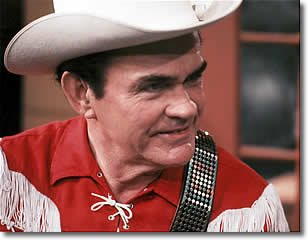 |
| Fred Kirby, on Whistle Stop |
People in the community were a big help. Phil Morris, an earlier WBTV children's show performer, provided some unusual costumes from his Charlotte store, Morris Costumes. A local Pet shop, Pet Haven, faithfully brought in pets. Bakeries and ethnic food places were willing contributors. The Charlotte Observer even allowed us to spend the better part of a day filming Bosco as he explored the process of putting together the newspaper.
Whistle Stop was a formula show much like "Laugh-In" and "Hee Haw." There was a taped opening with video of the hosts and the theme song that was written by Loonis McGlohan and myself. The theme song was recorded in Jeffersonics using a local Sunday School choir of six children and a seven-piece combo. We also recorded other format music such as the "Look A Likes" track that Clara would sing to.
The first scene of a typical Whistle Stop show was an introduction of the week's topic, such as "Being a helper." We would then go into a pre-taped character for two and a half minutes and then come back to the topic. Then another character or puppet sketch and back to the topic. My approach in formatting the show was the never have a bit longer than two and a half minutes. We often would wrap up with a recap of what we learned and letters from the viewers. One feature of every show was a song by Fred. He often would write a song just for that show's topic!
In the format, I chose to play only a minor talking role on camera, since I did most of the puppets and provided their character voices. For my on-camera parts I played a college student working as a baggage boy at the Whistle Stop station. At the time I was 24 years old. I wore a gray work uniform with a black bow tie and work cap.
|
||||||||||||||||
| Uncle Jim and the Alphabet Clown, who was invisible to Fred. |
The only other prominent character I played "live" was "The Alphabet Clown." This was a running gag on the show. Only Uncle Jim ever saw the Alphabet Clown. Jim kept trying to convince Fred that there was a clown with a suit with bright colored alphabet letters and numbers that lived at Whistle Stop. Fred always said the clown was only in his imagination. Jim would invent all kinds of way to "finally once and for all prove to Fred that there really is an Alphabet Clown." All of Jim's plans would backfire. At one point we were getting over a hundred letters a week into the TV station addressed to Fred Kirby with pictures of the Alphabet Clown drawn by children. During the closing letter segment Fred would sometimes mention the child's name and thank them for the nice picture but he would never mention the connection between the clown in the drawing the the Alphabet Clown!
"The Alphabet Clown" was an instant idea! My wife Cindy and I were fabric shopping for the new show in the summer of '72 at Mary Jo's Fabric outlet in Dallas. I came across the printed cloth with the letters and numbers and bright colors and looked at Cindy and said, "We have to make a clown suit out of this!" While she was making the suit I got the idea that it should be a running gag on the show and only Jim would ever see the clown and would always try to convince the other people on the show that there really was an "Alphabet Clown".
I did play a number of other "taped drop in" characters to fill out the format. All these characters were pre taped during the slow weeks in the studio in the summer and "rolled" into each show as we taped it on Thursday afternoons. These silent characters were:
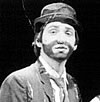 Bosco, a tramp clown who was very child-like and imaginative. He could make a play toy out of almost anything. One sketch we did that was requested many times to be repeated by delighted viewers was, "The Theme from Smash" ( Shaft). It was a pantomime sketch with Bosco sleeping on his park bench under newspapers. As the then popular "Theme from Shaft" began playing, a buzzing fly was periodically heard. The newspaper rustled and an annoyed Bosco's eyes could be seen in close up. The theme continued and the fly returned. Finally, Bosco rolls up the newspapers and is swatting at the fly to the beat of the emphatic musical parts of the Shaft theme! The sketch ended with the fly winning and Bosco walking away.
Bosco, a tramp clown who was very child-like and imaginative. He could make a play toy out of almost anything. One sketch we did that was requested many times to be repeated by delighted viewers was, "The Theme from Smash" ( Shaft). It was a pantomime sketch with Bosco sleeping on his park bench under newspapers. As the then popular "Theme from Shaft" began playing, a buzzing fly was periodically heard. The newspaper rustled and an annoyed Bosco's eyes could be seen in close up. The theme continued and the fly returned. Finally, Bosco rolls up the newspapers and is swatting at the fly to the beat of the emphatic musical parts of the Shaft theme! The sketch ended with the fly winning and Bosco walking away.
Dibble Dabble, a French artist with a yellow smock and red beret and Dali moustache. He always painted on his canvas frame with Chroma Key blue and the output of another camera provided the object. Once he painted a model train engine and as he was enjoying his creation the whistle blew and it rolled out of the frame.
Mr. Magic, a long red-haired old magician with a baggy set of tails. Usually the trick went wrong while he was performing it and he was unaware.
With the help of my wife Cindy, I created a whole family of puppets for the show.
Clickity Clack was an obnoxious crow that lived in the Whistle Stop ticket booth. I played the character live in my interactions with Jim. This was another running gag. Clickity Clack would always try to get Uncle Jim to open up the Peanut Brittle Snake can. This was a metal can with a twist top filled with spring snakes. Depending on the theme, Clickity Clack would decorate up the can to trick Jim. For example, if we were talking about "telling time" the can would be decorated like a clock and Clickity Clack would get Jim to "wind it up." Jim would always fall for the trick and open the can and be so frustrated that he let the spring snakes out of it.
 |
Casey Jonas (left) was a soft-headed old man puppet that talked about phonetics. Rocky Starr was a spoof on Dick Clark (I did the voice). |
 Harry the Hippie (right) was a long haired puppet with a headband and sunglasses and a beard, a kind of Jerry Garcia. Rocky would introduce a current pop song like "Dancin' in the Moonlight" and Harry would sing to it.
Harry the Hippie (right) was a long haired puppet with a headband and sunglasses and a beard, a kind of Jerry Garcia. Rocky would introduce a current pop song like "Dancin' in the Moonlight" and Harry would sing to it.
 Percival ("Percy") was a hyperactive green worm-like puppet who would try to be overly helpful to J. B. Featherstone (voice of Jim Patterson) a very prim and proper English butler.We extensively used sound effects to suggest off camera action. In one sketch Percy tried to wash dishes for J. B. and you could hear the rattling dishes and water running. Finally came a big crash. No dish was ever seen on camera but the sound effects made it believable.
Percival ("Percy") was a hyperactive green worm-like puppet who would try to be overly helpful to J. B. Featherstone (voice of Jim Patterson) a very prim and proper English butler.We extensively used sound effects to suggest off camera action. In one sketch Percy tried to wash dishes for J. B. and you could hear the rattling dishes and water running. Finally came a big crash. No dish was ever seen on camera but the sound effects made it believable.
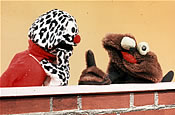 |
| Columbus and The Wooly Thing |
Christopher the Dog and Columbus the Cat and the Wooly Thing. This was Jim and I doing the puppets and voices. Most sketches involved the Wooly Thing sneaking in and doing something while they were not watching and then them blaming it on each other. Tony Johnson from the floor crew or Tom Olsen often did the Monster and voice.
The Tweebles were fuzzy three-inch key-chain puffs mounted on the end of a coat hanger with eyes attached. Their song would play and they would bounce around the screen and knock into each other, by way of Chroma Key, while I would draw a sketch of something.
Rusty and Elmer, two ventriloquist dummy heads sticking up over a wooden fence. They would exchange riddles with each other and invite the viewers to send in riddles.
Archie O'Tool was my ventriloquist figure. Sometimes I would appear on camera with him doing a short ventriloquism dialog in front of a vaudeville show curtain.
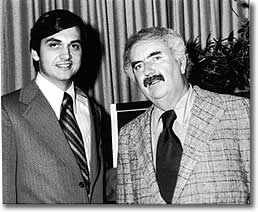 |
| Dennis Phillips with Bob Keeshan (Captain Kangaroo) - June 1973 |
I believe the high point for the show was in June of 1973 when we were selected as one of the top ten examples of quality local children's television programming. Pat Lee and I flew to the University of Cincinnati where they projected a clip of Whistle Stop on the big auditorium screen. Present in the audience was almost everyone in the United States connected with children's television. Bob Keeshan, Captain Kangaroo, George Heinemann, NBC Children's programming head and creator of Ding Dong School. Duke Dukovney, head of CBS Children's programming. Lee Polk for ABC filling in for his boss Michael Eisner (Yes, the Disney guy). Joe Barberra, of Hanna and Barberra fame. In addition there were hundreds of major market TV programming executives. I had been to the mountain top! Where do I go from there?
It became obvious to me that regardless of how good and how creative a local children's show was, the TV business was beginning to shift away from local production. Television was changing. It would take another decade for the incursion of cable TV into the home, satellite distribution and home video recording to end local program production.
I kept up my enthusiasm for Whistle Stop for the next two seasons. The format matured a bit. I introduced my newborn son Clay and my wife Cindy on the air in October of 1973. The theme of that show was "How to treat a brand new baby." I showed the soft spot in the top of the baby's head and showed how to hold the baby. Fred sang to Clay. Today Clay is the head of the Social Studies Department at the largest high school in Orlando.
|
||||||||||||||
| Uncle Jim and Clickity Clack, the mail-stealing crow. |
For the second season our time was shifted to 8 AM on Saturdays. The local salesmen explained how difficult it was to sell a "local children's show." The vast buyers of TV spots were national and regional companies. The advertising agency buyers in distant cities did not understand or know about the show and would only buy what they knew, syndicated programs. In the local Charlotte area, potential advertisers were limited to dairies, toy stores, fast food and clothing stores. The power of the local show was that the local host could do an on-camera pitch. When the FCC eliminated that possibility, the value of the advertising was diminished.
|
||||||||||||||
| The puppet show stage manned by Dennis and Jim. |
The 1974 season saw Whistle Stop shift to Sunday Mornings at 8 AM. The viewing potential was much less and though our share stayed up, the total number of viewers dropped. The station kept us on the air and justified the production expense as a community service and a help with license renewal. By this time I was spending less time on Whistle Stop and more time on other productions. I believe that the quality of the show stayed up because we had a successful formula and a lot of experience.
In early 1975, I decided to go back to college and work on a graduate degree. Cindy and I had a baby daughter in January of 1975. It was becoming clear that my predictions from a couple of years before were coming true. The local stations were beginning the process of cutting back on local productions and adding much more news. I worked through the summer at WBTV and assisted my replacement for the next season on Whistle Stop, Jim Strader.
In September of 1975 Cindy and I moved to Orlando, Florida and opened a costume shop and production company. Today she runs the business and I am a theater professor. I would not trade my time at WBTV for anything. The station had such leadership in the market that they believed they should produce quality local programs. They believed their personalities and programs were the reason they maintained their advantage. They were a shining light in broadcasting until the changing business climate and technology brought that wonderful era to a close.
—Dennis W. Phillips
Orlando, Florida - June 2006
Photos courtesy Dennis Phillips. See another Whistle Stop photo in the Kids' Stuff gallery.
Editors Note: Dennis and Cindy moved to Harrisonburg, Va. in the summer of 2009.